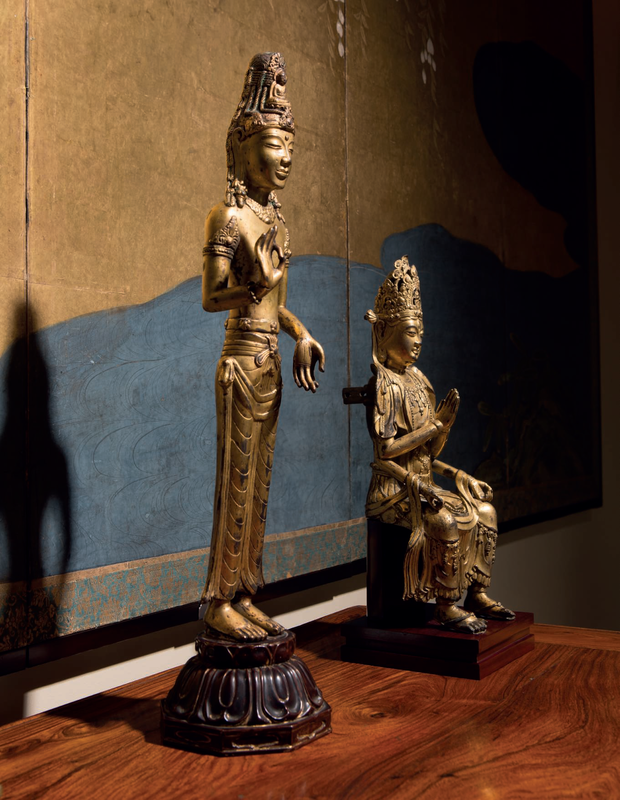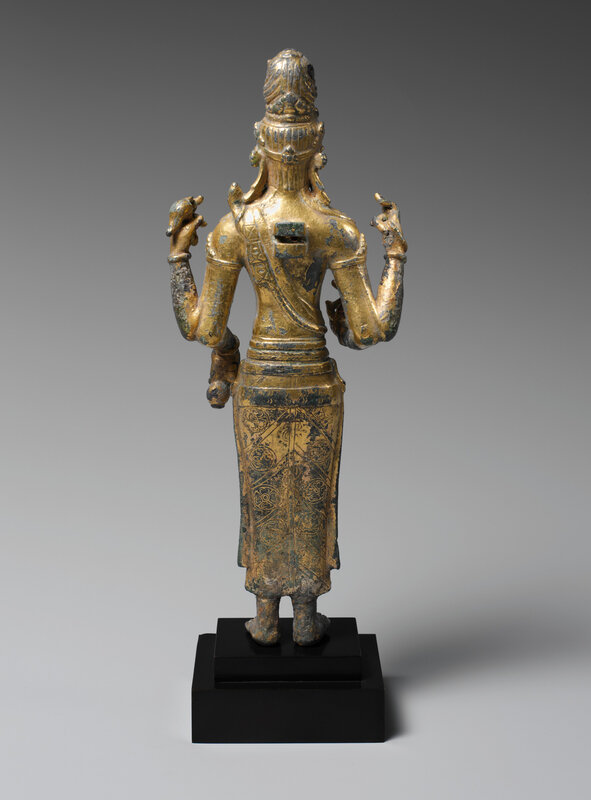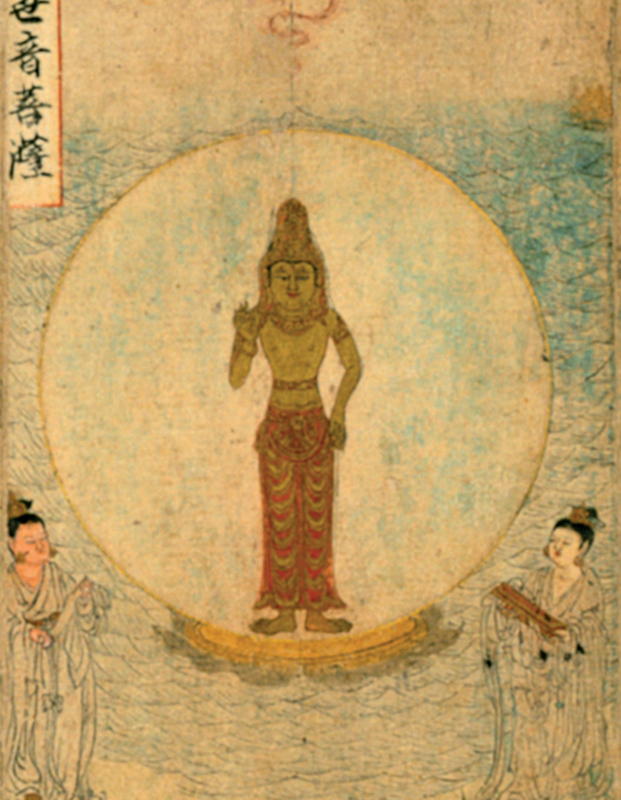The “Luck of Yunnan”. A rare gilt-bronze standing figure of an Acuoye Guanyin, China, Yunnan, Dali Kingdom, 12th century
Lot 813. A rare gilt-bronze standing figure of an Acuoye Guanyin, China, Yunnan, Dali Kingdom, 12th century; 18 in. (45.7 cm.) high, 18 in. (45.7 cm.) high. Estimate USD 2,000,000 - USD 3,000,000. Price realised USD 1,935,000. © Christie's Images Ltd 2019
The tall, slender figure shown standing with right hand raised in vitarkamudra and left held in varadamudra, the long hair drawn up into a tall coiffure (jatamukuta) bound by a band and elaborately dressed in twisted cords falling in loops around and flanking a central seated image of Amitabha Buddha and falling to the shoulders behind the earring-hung ears, wearing a jeweled necklace and arm bands and a floret-decorated belt worn above the waist and the top of the dhoti secured by a knotted sash, the upper back with a rectangular opening and the back of the upper legs with a square casting patch, lacquered softwood base.
Provenance: Private Collection, United States, acquired in Tokyo in 1946.
The property of a gentleman; Christie’s New York, 6 November 1980, lot 209.
Robert H. Ellsworth, New York.
The Irving Collection, no. 1949.
Literature: Ann Ray Martin, "American Mandarin," Connoisseur, November 1984, p. 101.
The “Luck of Yunnan”
Standing Bodhisattva Acuoye Avalokiteshvara
Termed the “Luck of Yunnan” by American scholar Helen Burwell Chapin (1892–1950), sculptures of this type represent the Bodhisattva Acuoye Guanyin and were produced in the twelfth century in the Dali Kingdom (AD 937–1253), an independent state in southwestern China that was coeval with China’s Song dynasty (AD 907–1279) and more or less congruent with present-day Yunnan province.
The comparatively large image of a seated Buddha Amitabha at the base of the figure’s high topknot of hair identifies this sculpture as the bodhisattva Avalokiteshvara, the bodhisattva of Infinite Compassion, known formally in Chinese as Guanshiyin Pusa and informally as Guanyin. Considered a spiritual emanation of Amitabha, Avalokiteshvara is the only bodhisattva in whose crown or headdress Amitabha appears, and thus Amitabha’s presence here definitively identifies this figure as Avalokiteshvara.
Standing upright with his weight evenly distributed on both legs, the bodhisattva holds his left hand in the varadamudra, or gift-giving gesture, in which the hand is lowered, palm outward. (A ritual hand gesture, a mudra symbolizes a particular action, power, or attitude of a deity.) He holds his right hand, raised to chest height, in the vitarka mudra, in which the tips of thumb and index finger touch to form a circle; this mudraemblemizes both intellectual discussion and the transmission of the Buddha’s teachings. Together, the combination of vitarka and varada mudras indicates that the bodhisattva is preaching.
The Chinese term for this type of Guanyin image, “Acuoye Guanyin”, first appeared in the Nanzhao tuzhuan, a long, illustrated handscroll depicting the history of the Nanzhao Kingdom now in the collection of the Fujii Yurinkan, Kyoto. The scroll, dated by inscription to AD 898, represents the prophecy made by an Indian monk, which predicted the rise to power of the Meng family and the casting of a bronze Acuoye Guanyin modeled on the monk’s mental vision. The Indian monk, who demonstrated various supernatural deeds, was actually a manifestation of Acuoye Guanyin. This leads to one theory that the name “Acuoye” is a transliteration of the Sanskrit term acharya, which means “preceptor”. (See Gong Jiwen, ‘A Fine Arts Anthropology Study on Avalokitesvara Iconography in Kingdom of Nanzhao-Dali’, Ph.D. diss., Yunnan University, 2017, pp. 1 and 156). Other scholars have suggested that the name “Acuoye” may be a transliteration of the Sanskrit term ajaya, which means “all victorious”. Invested with miraculous powers, the sculpture was adopted by the Meng family as its tutelary deity and witnessed the family’s rise to royal status and fostered the establishment of the Nanzhao Kingdom (738–937), which controlled Yunnan during the eighth and ninth centuries. From 937 onward, the same region, by then controlled by the Duan family, became known as the Dali Kingdom (AD 937–1253). While the Chinese emperor based his legitimacy on the Mandate of Heaven, the Yunnan monarchs grounded theirs on the will of Guanyin. The possession of a special image, a palladium in the form of the Acuoye Guanyin, thus conferred legitimacy on the ruler. In that context, a tutelary deity called ajaya, or “all victorious”, stood as an appropriate reference for an icon associated with members of a ruling family. (Adapted from Denise Patry Leidy, Donna Strahan, et al., Wisdom Embodied: Chinese Buddhist and Daoist Sculpture in the Metropolitan Museum of Art, New York: The Metropolitan Museum of Art, 2010, pp. 136-38, no. 32.)
Fashioned in gold and backed by an elaborate, openwork mandorla, the eighth- or ninth-century Acuoye Guanyin discovered in 1978 inside the Qianxun Pagoda at the Chongsheng Temple, Dali, Yunnan province, is both the earliest and the most prominent example of the tutelary deity of the Nanzhao and Dali kingdoms. (see: Leidy and Strahan, Wisdom Embodied, p. 136, fig. 99) This effigy of Guanyin, which was replicated through successive dynasties, is the model from which derive the several related twelfth-century sculptures including the present example. (See Angela F. Howard, “Buddhist Monuments of Yunnan: Eclectic Art of a Frontier Kingdom” in Maxwell Hearn and Judith G. Smith, eds., Arts of Song and Yuan: Papers Prepared for an International Symposium, New York: The Metropolitan Museum of Art, 1996, pp. 231-45)
This figure’s slender body, elongated proportions, and distinctive facial features are typical of Dali-Kingdom sculptures, as are the torque, the long earrings that rest on the shoulders, and the arrangement of the hair in an Indian-style jatamukuta. Those features not only distinguish such images from sculptures produced in Song-dynasty China but closely link them to sculptures created in India and Southeast Asia. In fact, the slender body, clinging drapery, and fashioning of the hair in a jatamukuta find parallels in such Buddhist and Hindu sculptures from Indonesia as three seventh-to-ninth-century bronzes in the collection of The Metropolitan Museum of Art, New York: 2004.556, 1987.142.160, and 1987.218.15. Apart from possible relationships with Indonesian sculptures, elements of the Acuoye Guanyin bear a striking resemblance to those of a ninth-century, sheet gold and electrum sculpture of an Avalokiteshvara from Champa now in the collection of the Asian Civilizations Museum, Singapore (See https://www.buddhistdoor.net/features/the-new-ancient-religions-gallery-at-the-asian-civilisations-museum-singapore). To wit, the matted hair piled high on the head and bound together with cords in a jatamukuta, the proportionally large image of the Buddha Amitabha set at the base of the jatamukuta, the slender body with a torque embellishing the neck, the scarf tied at either hip and looping below the waist, and the subtle drapery folds that delicately flow over the legs all suggest possible influence from Champa, in present-day central Vietnam, on the sculpture of the Dali Kingdom. (See Albert Lutz and Angela Falco Howard, Der Goldschatz der drei Pagoden: Buddhistische Kunst des Nanzhao- und Dali-Konigreichs in Yunnan, China, 1st ed., Zurich: Museum Rietberg, 1991, pp. 68-74)
Standing Four-Armed Shiva, Indonesia, 8th–9th century. Gilt bronze, H. 11 in. (27.9 cm); W. 4 1/4 in. (10.8 cm). Gift of Nancy Wiener, 2004. © The Metropolitan Museum of Art, New York
Standing Bodhisattva on Tall Base, Indonesia (Java), 9th century. Bronze, H. 5 9/16 in. (14.1 cm). Samuel Eilenberg Collection, Gift of Samuel Eilenberg, 1987. © The Metropolitan Museum of Art, New York
Standing Bodhisattva Maitreya or Manjushri(?), Indonesia (Sumatra), late 7th–early 9th century. Bronze. H. 9 1/4 in. (23.5 cm); W. 2 3/4 in. (7 cm); D. 1 7/8 in. (4.8 cm), Samuel Eilenberg Collection, Ex Coll.: Columbia University, Purchase, Pfeiffer Fund, 1987. © The Metropolitan Museum of Art, New York
Lokeshvara, Central Vietnam, Champa, 9th century, sheet gold and electrum. Gift of Joe Grimberg and Rosalind Shellim in memory of Aaron Brooke David. © Asian Civilizations Museum, Singapore.
Sculptures of the Acuoye Guanyin are dated to the second half of the twelfth century on the basis of their similarity to a sculpture in the collection of the San Diego Museum of Art (1941.83) that bears an inscription that dates it between 1147 and 1172. That date is further confirmed by the striking resemblance of such sculptures to a golden image depicted in the so-called Long Scroll of Buddhist Images (Fig. 1) painted between 1172 and 1190 by Zhang Shengwen (active 1163–1189) and now in the collection of the National Palace Museum, Taipei. (See Leidy and Strahan, Wisdom Embodied, p. 136, fig. 98)
Fig. 1 An image of Acuoye Guanyin shown in Scroll of Buddhist Images, by Zhang Shengwen (active 1163–1189), Dali Kingdom (AD 937-1253). © The Collection of National Palace Museum
Closely related sculptures of the Acuoye Guanyin appear in a number of collections in both Asia and the West, including the Yunnan Provincial Museum, Kunming; The Metropolitan Museum of Art, New York (42.25.28); Freer Gallery of Art, Washington, DC (F1946.10a-b); Asian Art Museum, San Francisco (B60S34); San Diego Museum of Art (1941.83); Brooklyn Museum; National Palace Museum, Taipei; Victoria and Albert Museum, London; Musée Guimet, Paris; and Sumitomo Collection in the Sen-oku Museum in Kyoto, Japan.
Robert D. Mowry
Alan J. Dworsky Curator of Chinese Art Emeritus, Harvard Art Museums, and Senior Consultant, Christie’s.
Christie's. Lacquer, Jade, Bronze, Ink: The Irving Collection Evening Sale, New York, 20 March 2019

/https%3A%2F%2Fprofilepics.canalblog.com%2Fprofilepics%2F1%2F0%2F100183.jpg)
/https%3A%2F%2Fstorage.canalblog.com%2F03%2F02%2F119589%2F96711876_o.jpg)
/https%3A%2F%2Fstorage.canalblog.com%2F11%2F31%2F119589%2F94773502_o.jpg)
/https%3A%2F%2Fstorage.canalblog.com%2F20%2F83%2F119589%2F94772815_o.jpg)
/https%3A%2F%2Fstorage.canalblog.com%2F26%2F72%2F119589%2F75604929_o.jpg)
/https%3A%2F%2Fstorage.canalblog.com%2F59%2F60%2F119589%2F26458628_o.jpg)




















/http%3A%2F%2Fstorage.canalblog.com%2F16%2F21%2F119589%2F128022917_o.jpg)
/http%3A%2F%2Fstorage.canalblog.com%2F68%2F11%2F119589%2F91847997_o.jpg)
/http%3A%2F%2Fstorage.canalblog.com%2F94%2F98%2F119589%2F128936844_o.jpg)
/http%3A%2F%2Fstorage.canalblog.com%2F10%2F21%2F119589%2F128720387_o.jpg)